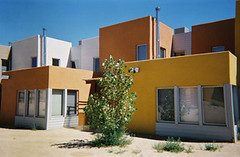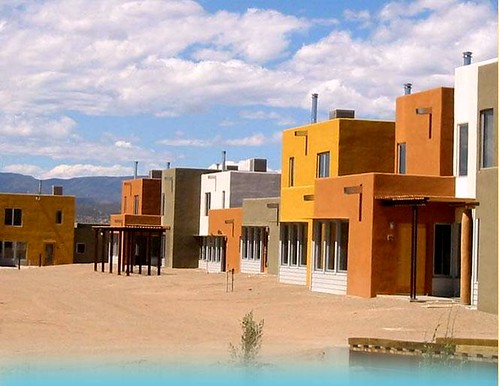A new Native American village based on tradition helps a Tribe reclaim its sustainable roots

Posted February 8, 2012 at 1:30PM
The Ohkay Owingeh Tribe and Pueblo in New Mexico has returned to its roots with an award-winning, mixed-income housing project based on traditional Native forms. It's an exciting and inspiring project.
Built by the Ohkay Owingeh Housing Authority explicitly as an alternative to sprawl-type housing, Tsigo Bugeh Village is a $5.3 million residential community that reflects traditional pueblo living with attached units divided around two plazas, one oriented to the solstice and the other to the equinox, as the tribe’s original pueblo was built. As the Housing Authority’s website points out, the homes are attached, their scale and massing similar to the original Ohkay Owingeh pueblo: “this is key to our architectural heritage, and the idea of community living that is central to our way of life.”
As someone who has a part Cherokee ancestry and is proud of it, I can’t help but feel a bit of wistful irony in the accomplishment, given that Native American settlements were in so many respects the original sustainable communities in North America, before the arrival of European colonists. Indeed, the well-known sustainable development firm Jonathan Rose Companies highlights the pueblo form as a model:
“Like villages in the Himalayas, [traditional] Pueblo villages have a clear edge and are surrounded by fields of sustenance. The community is organized in a progression of spaces from the private realm, to the semi-private, to the most public reality, the plaza, or town square. Culture after culture, each with different ecosystems, have built their communities this way. We believe this is the natural form for human communities.”
Tsigo Bugeh Village places 40 rental homes on a 6.5-acre site. Nine have been made available at market rates, the rest reserved for those earning between 40 and 60 percent of the area median income. The Village also includes a number of traditional outdoor ovens for community use, along with a community center featuring a large kitchen, business center, exercise rooms, and laundry facilities.
The Village was built pursuant to a larger master plan to guide the Ohkay Owingeh Pueblo’s future. Bestowing a national award for smart growth achievement in 2004 (when the pueblo was known as the San Juan Pueblo), the federal Environmental Protection Agency hailed the plan as the first smart growth model for Native American tribes:
“It provides a long-term growth strategy, coordinates existing infrastructure with housing and commercial development, preserves the walkable historic plazas, and encourages retail and commercial uses in a ‘main street’ style. The plan also includes design guidelines that enhance the traditional building pattern to preserve the architectural heritage of the pueblo, fostering a distinctive sense of place.”
 Implementation of the plan is guided by a Tribal Planning Department and a community advisory council of neighborhood representatives.
Implementation of the plan is guided by a Tribal Planning Department and a community advisory council of neighborhood representatives.
The Housing Authority’s website points out that “Tribal leaders realized that continuing to develop sprawl housing would severely limit the land base for agricultural use and open space for future generations.” A premium was placed on involvement from the Tribal community and respect for the Pueblo’s traditions:
“This is the first tribally driven planned housing development on the reservation since the creation of the traditional housing constructed over 400 years ago, and it is the only rental housing on the pueblo. As a result, OOHA placed a focus on planning, and sought community involvement and input. We held a series of meetings to understand what our community’s housing needs were, and we asked people to tell us how their home could support their values: social, family, cultural and spiritual. We asked them what materials were most important to them in a home, and whether their current homes satisfy any of these values or needs.
“We also had esteemed storytellers in the community come to the meetings and describe their experiences growing up in the historic core of the Pueblo, with everyone’s grandmother watching over them as they played, the yearly whitewashing of plaster under the portals,
and the seed ball game that was played every spring. As a result, not only was the site plan and building massing built similarly to the old pueblo, but the floor plans were developed to accommodate the many people that come through the homes on feast days.”
The Village’s landscaping comprises all native, drought-resistant plantings. The homes are equipped with energy-efficient, high-insulation windows, and those that face south have overhangs for passive solar gain. The process and financing were not simple, but that just brings all the more credit to the Tribe and Housing Authority for such an outstanding result.
I did a bit of research on the history of the Ohkay Owingeh Tribe while preparing this article. As you might imagine, it has been rich but not pretty, especially during the many years of Spanish rule, followed by those of American occupation. Only with a Supreme Court ruling in 1913 and Congressional passage of the Pueblo Lands Board Act of 1924 was the Tribe able to fully reclaim title to Pueblo land. In the decades sense, Tribal members have blended their traditions with participation in the larger American economy. In a sense, the master plan and the completion of Tsigo Bugeh Village represents a culmination of the Tribe’s reassertion of its right to a sustainable future.
Move your cursor over the images for credit information.
Please also visit NRDC’s sustainable communities video channel.
